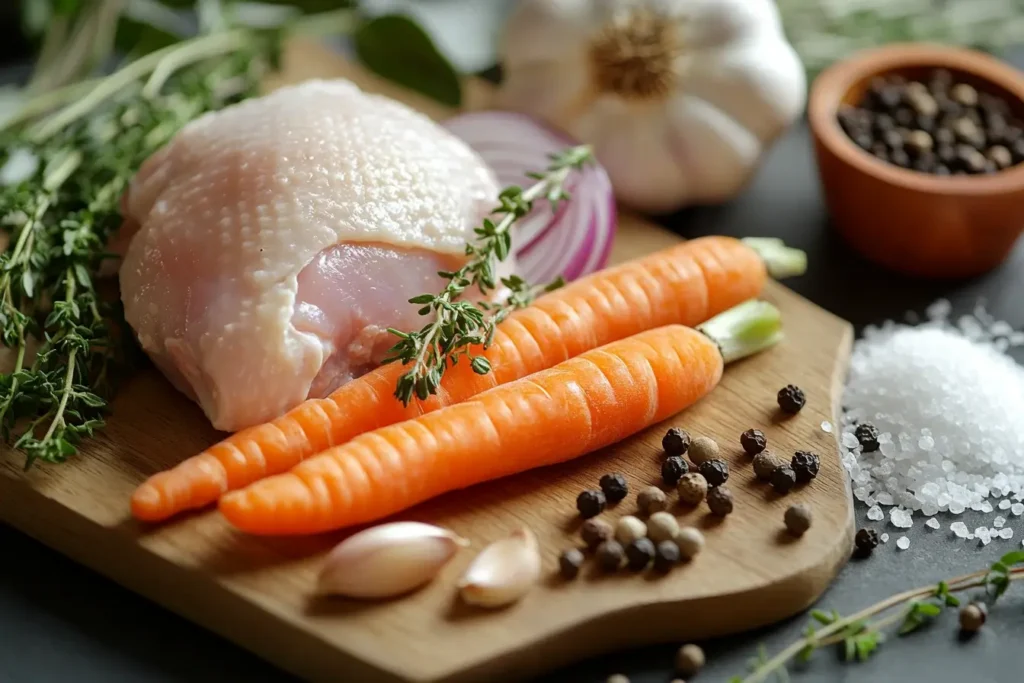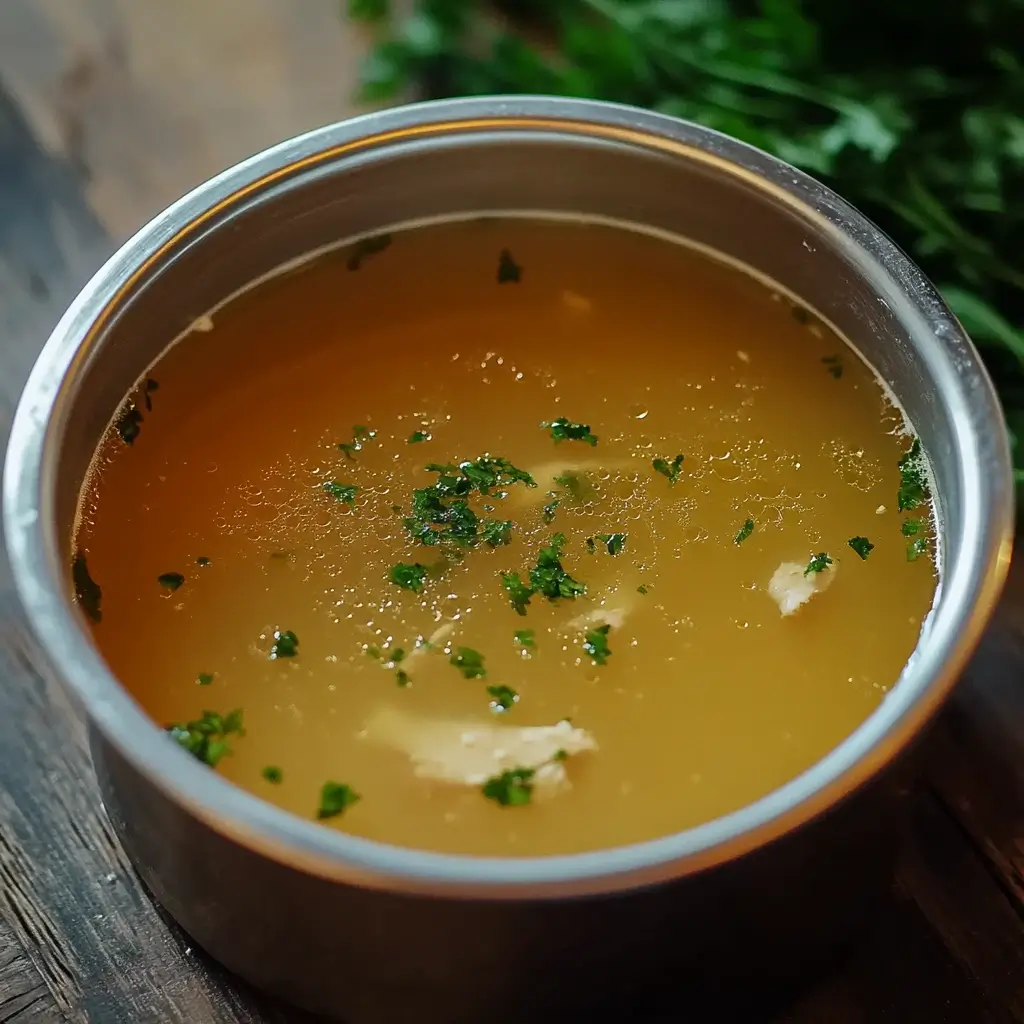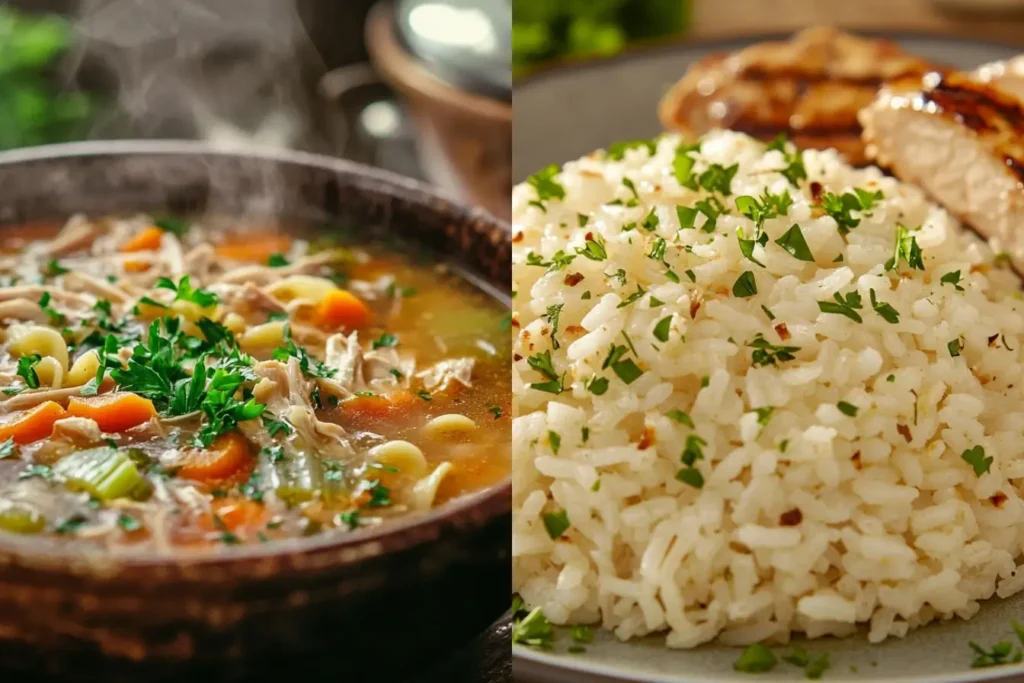Let’s talk about chicken bouillon—the pantry MVP you didn’t know you were missing. Honestly, it’s that secret ingredient that can transform your soups, sauces, and even rice from bland to absolutely crave-worthy. Whether you’re a seasoned chef or just trying to get dinner on the table after a long day, chicken bouillon is here to save the day.
In this guide, I’ll cover what it is, how to use it, and even some fun recipes to try. Plus, I’ll answer all the FAQs that pop up about this magical ingredient. So, let’s dive right in and uncover the wonders of chicken bouillon!
Table of Contents
What Is Chicken Bouillon?
First things first—what exactly is this popular kitchen staple? Essentially, it’s a concentrated form of chicken stock that’s been dehydrated into powder, cubes, or paste. In other words, it’s the essence of chicken soup packed into a convenient, shelf-stable package.
This product often includes chicken stock, salt, spices, and sometimes flavor enhancers like MSG. It’s designed to dissolve quickly in water, making it a perfect shortcut for recipes that require broth or stock.
Types of Chicken Bouillon
There’s more than one way to get your bouillon fix. To clarify, here are the main types you’ll find in stores:
- Cubes: These little blocks of flavor are the most common form. Typically, you’ll dissolve one cube in hot water to make a cup of broth.
- Powder: This is bouillon in its most versatile form. You can sprinkle it directly into recipes or mix it with water to create broth.
- Paste: Found in jars, bouillon paste tends to have a richer flavor. It’s great for those seeking a more gourmet taste.
- Liquid Concentrate: These packets or bottles of concentrated broth are like bouillon’s fancy cousin, offering a quick and flavorful option.
The Role of Chicken Bouillon in Global Cuisine
Chicken bouillon isn’t just an American staple—it’s a flavor enhancer used worldwide. In Latin America, brands like Maggi are commonly added to soups, stews, and even rice dishes. In Asian cuisine, chicken bouillon powder often appears in noodle soups, fried rice, and marinades. In African cooking, bouillon cubes are key ingredients in hearty dishes like jollof rice and stewed meats.
Understanding how different cultures incorporate chicken bouillon can inspire you to try new recipes and experiment with bold, international flavors. Don’t be afraid to take your cooking in a new direction!
Homemade Chicken Bouillon Recipe

Ingredients:
- 2 lbs chicken bones (raw or cooked)
- 1 large onion, roughly chopped
- 3 garlic cloves, smashed
- 2 celery stalks, chopped
- 2 medium carrots, chopped (optional)
- 1 bay leaf
- 1 tsp black peppercorns
- 1 tsp salt (adjust to taste)
- 8 cups water
- Optional: fresh herbs like thyme, parsley, or rosemary
Instructions:
- Prepare the Ingredients:
Place the chicken bones, onion, garlic, celery, carrots (if using), bay leaf, and black peppercorns in a large pot. Add any fresh herbs you’d like for additional flavor. - Simmer the Stock:
Pour the water over the ingredients and bring it to a boil over high heat. Once boiling, reduce the heat to low, cover partially, and let it simmer for 3-4 hours. Stir occasionally and skim off any foam that rises to the top. - Strain the Stock:
After simmering, strain the liquid through a fine mesh sieve or cheesecloth into another pot or large bowl. Discard the solids. - Reduce the Liquid:
Return the strained stock to the stove and simmer it over low heat until the liquid reduces to about one-fourth of its original volume. This concentrated stock will have a thick, syrupy consistency. - Season with Salt:
Stir in the salt, adjusting the amount to suit your taste. Remember, this is a concentrated bouillon, so it will be naturally more intense in flavor. - Cool and Store:
Allow the bouillon to cool slightly, then pour it into ice cube trays. Freeze until solid. - Transfer and Use:
Once frozen, transfer the bouillon cubes to a freezer-safe container or zip-top bag. Store in the freezer for up to 3 months. Use one cube as a substitute for a bouillon cube or one cup of broth in recipes.
This homemade version gives you complete control over the ingredients and flavor, making it a fantastic choice for those who prefer natural, additive-free options. Enjoy the extra depth it brings to your dishes!

How to Use Chicken Bouillon
Chicken bouillon is a multitasker in the kitchen, and you’ll find yourself reaching for it again and again. Here’s how you can use it to elevate your meals:
- Make Quick Broth
Dissolve the recommended amount of bouillon in hot water for a quick and easy broth. This is especially helpful when you’re out of fresh or boxed stock. - Boost Flavor in Soups and Stews
Even if you’re using homemade broth, adding a pinch of bouillon can bring added depth to your soup. A teaspoon in your chicken noodle soup will make all the difference. - Season Rice, Pasta, or Grains
Add bouillon to the cooking water for rice, pasta, or grains like quinoa. It’s an easy way to add rich flavor. - Sprinkle Into Roasted Vegetables
Sprinkle a little bouillon on your roasted or sautéed vegetables for an umami punch. It’s an easy way to enhance flavor without adding extra salt. - Use as a Dry Rub
Mix powdered bouillon with herbs and spices for a simple dry rub on chicken, steak, or vegetables. It’s an easy way to boost the flavor of your meats. - Make Gravy
Whisk bouillon into your gravy base for a rich, flavorful sauce. It’s a perfect complement to mashed potatoes or roasted meats.
Recipes Using Chicken Bouillon
Now for the fun part—how to cook with chicken bouillon. To illustrate its versatility, here are a few recipes that’ll have you reaching for that jar (or cube) again and again:
1. Classic Chicken Noodle Soup
Ingredients:
- 1 tbsp olive oil
- 1 onion, diced
- 2 carrots, sliced
- 2 celery stalks, chopped
- 2 garlic cloves, minced
- 6 cups water
- 2 chicken bouillon cubes (or 2 tsp powder)
- 2 cups cooked chicken, shredded
- 1 cup egg noodles
- Salt and pepper to taste
Instructions:
- Heat olive oil in a large pot. Sauté onion, carrots, celery, and garlic until softened. Meanwhile, dissolve bouillon in hot water.
- Add water and bouillon to the pot, stirring to combine.
- Bring to a boil, then add chicken and noodles. Cook until noodles are tender. Finally, season with salt and pepper. Serve hot.
2. Flavored Rice Side Dish
Ingredients:
- 1 cup rice
- 2 cups water
- 1 chicken bouillon cube
- 1 tsp butter or olive oil
Instructions:
- Dissolve the bouillon in water and bring to a boil. Next, add rice and butter.
- Reduce heat, cover, and simmer until rice is cooked.
- Fluff with a fork before serving. Notably, this works great as a side dish for grilled chicken.

Is Chicken Bouillon Healthy?
While chicken bouillon can make meals more flavorful, it’s important to note that it’s generally high in sodium. However, many brands now offer low-sodium or organic options, which are healthier alternatives. When used in moderation, bouillon can be part of a balanced diet, but always check labels to make sure you’re choosing the best version for your health needs.
Can Chicken Bouillon Fit Into Special Diets?
While it’s versatile, its compatibility with certain diets depends on the product and its ingredients. For example, traditional bouillon may not suit gluten-free diets if it contains additives derived from wheat. Similarly, those following low-sodium diets should be cautious, as regular bouillon is often high in salt. On the other hand, there are low-sodium and gluten-free options readily available, making it easier to adapt bouillon to your dietary needs. For those on plant-based diets, “chicken-flavored” vegetable bouillon provides a suitable alternative with similar savory notes.
Tips for Storing Chicken Bouillon
Proper storage can significantly extend the life of your chicken bouillon. Typically, bouillon cubes and powders should be stored in a cool, dry place, away from direct sunlight. For paste or liquid concentrates, refrigeration is usually required after opening. Additionally, resealing jars or bags tightly can help preserve their flavor and prevent clumping. For long-term storage, consider transferring bouillon powder to an airtight container to keep it fresh. By following these simple steps, you can ensure your bouillon stays flavorful for months—or even years.
Common Mistakes When Using Chicken Bouillon
While this seasoning is easy to use, there are a few common mistakes to watch out for. First, overusing it can lead to overly salty dishes, especially when combined with other salted ingredients. Additionally, some cooks forget to dissolve it completely, which can leave gritty chunks in the final dish. Lastly, it’s not always the best choice for recipes requiring a lighter, less concentrated flavor. For example, while it works beautifully in hearty stews and soups, a mild broth may be a better option for delicate sauces or poached dishes.
Chicken Bouillon vs. Chicken Stock
If you’re wondering, “Can I just use stock instead?” the answer is yes, but there are differences. Stock is typically homemade or store-bought liquid that’s simmered with chicken bones and veggies. On the other hand, bouillon is more concentrated and shelf-stable, making it quicker and more convenient.
The Science of Umami in Chicken Bouillon
One of the reasons this ingredient is so popular is because it’s loaded with umami—the savory flavor that makes food irresistible. Thanks to components like chicken stock and sometimes MSG, it delivers a deep, rich taste that enhances the flavor of your dishes.
Interestingly, umami is a natural flavor booster, which explains why even a small amount can transform a recipe. For the ultimate umami experience, consider pairing it with other umami-rich ingredients such as mushrooms, soy sauce, or Parmesan cheese.
Creative Uses for Chicken Bouillon You Might Not Have Tried
We all know chicken bouillon is great for soups and stews, but have you thought about using it in unexpected ways? For example, you can mix a small amount into scrambled eggs for a savory twist. Or, add a pinch to your burger patties to give them extra flavor.
Another idea is to sprinkle powdered bouillon into homemade salad dressings. It might sound unusual, but it adds depth to vinaigrettes and creamy dressings alike. With a little creativity, you can find endless uses for this versatile ingredient.
FAQs
1- What exactly is chicken bouillon?
Chicken bouillon is a concentrated form of chicken stock available in cubes, powder, paste, or liquid. It’s made from chicken stock, salt, and seasonings, creating a quick, shelf-stable way to make broth by simply dissolving it in water.
2- What can I use instead of chicken bouillon?
Chicken broth or stock is the best substitute, used in the same quantity as water and bouillon combined. Vegetable broth, soy sauce, or a mix of salt, garlic powder, and herbs can also work in a pinch.
3- Does chicken bouillon have nutritional value?
Bouillon is low in calories but often high in sodium. While it may contain small amounts of protein, it’s not a significant source of nutrients. Low-sodium versions are available for healthier options.
4- Can I drink chicken bouillon?
Yes, chicken bouillon can be enjoyed as a warm, savory drink. Just keep an eye on the sodium content if you’re drinking it regularly.
5- Is bouillon better than stock cubes?
Bouillon paste or powder often has a richer flavor and dissolves faster, while cubes are more compact and convenient. Both work well, so it’s a matter of preference.
6- Is vegetable bouillon healthy?
Vegetable bouillon is a healthy, low-fat option, especially for plant-based diets. However, check the sodium levels or opt for low-sodium varieties for a better choice.
Finally
Chicken bouillon is like the little black dress of the kitchen—simple, versatile, and always in style. Whether you’re whipping up a quick soup, seasoning rice, or adding depth to a sauce, it’s a must-have ingredient.
Next time you’re in the grocery store, grab a jar or a pack of cubes, and start experimenting. Without a doubt, your taste buds will thank you!


